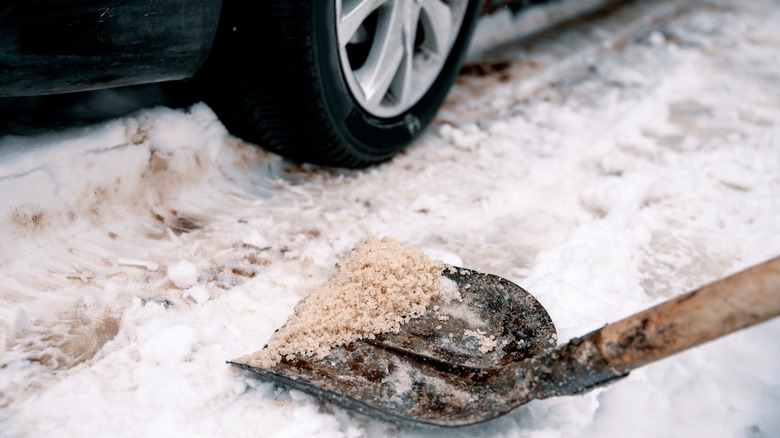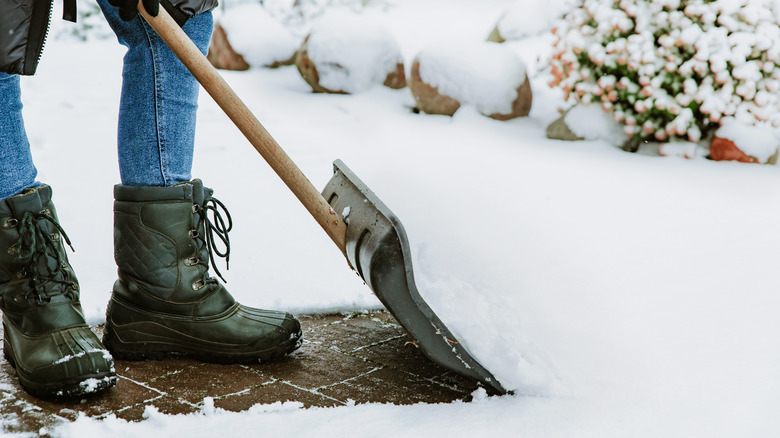The Unexpected Use Leftover Coffee Grounds Have In The Winter
Winter is a beautiful time of year, but the problem with winter comes when you have to start dealing with snow. This process typically involves spending hours in the cold shoveling and then pouring road salt everywhere to de-ice your front steps and driveway and make them safe for walking. However, during snowy years, salt can run out quickly. You probably already know that if you run out of salt, sand can be used as a temporary replacement and can be added on top of ice to create more traction. However, what you may not have known is that leftover coffee grounds can also be used as a road salt replacement in a pinch.
The main use of coffee grounds in the winter is — like sand — to help you add traction to icy areas. It is important to know that (despite it being a common myth) coffee grounds cannot melt ice on their own. As Bangor Daily News reports, on a sunny winter day, both coffee grounds and sand will attract and absorb light due to their darker color. This quality may help melt ice, but it has nothing to do with the chemical composition of coffee and definitely won't be as efficient or fast as road salt. Luckily, even though coffee grounds won't necessarily melt the ice, that doesn't mean that the leftover coffee particles can't be a useful part of your anti-ice arsenal.
How to use coffee grounds on icy paths
Because most of us probably don't drink enough coffee to coat our entire driveway with leftover grounds, the best option is to use the leftover coffee with other ice-melting tools. To help your road salt last longer, you can mix your saved-up coffee grounds with the salt and then spread the mixture on your driveway as a way to both melt slippery ice and add traction. This method will not only help you save money but is also better for the environment. Road salt contains two chemicals that both have negative effects on the environment: chloride, which is harmful to fish and other wildlife, and sodium, which is harmful to your lawn and garden (via Minnesota Public Radio).
Instead of mixing the coffee grounds with the road salt, another option to use the two in combination is to pick and choose which areas of your driveway and yard will get coffee and which will get salt. For example, you can use road salt on important areas that need to be ice-free like your front stairs and the pathway from your car to your house. However, in other areas where salt may cause damage to your plants and soil (like a shoveled path through your yard to your shed or along the edges of your driveway near the grass), you can choose to use coffee grounds instead.
Other environmentally friendly ice treatment options
Besides traction enhancers like sand and ground coffee, a few other de-icing options are being tested around the world to try and replace road salt. So far, the most successful seems to be sugar beet juice which is useful because it helps lower the melting point of ice. However, according to EcoWatch, sugar beet juice works best in combination with road salt because mixing the two makes a combination that melts the same amount of ice with less salt. Plus, sugar beet juice is almost completely biodegradable and safe for pets and cars.
Another common environmentally friendly de-icing option is alfalfa meal. This product is normally used as a fertilizer and can be purchased at any garden center. Although alfalfa meal also won't melt ice as well as road salt, it's a good moderate de-icer for thin ice patches.
Another de-icing option that is effective and much better for the environment is calcium magnesium acetate (CMA). However, while CMA can successfully melt ice in lower temperatures than road salt and is an all-around better option for the environment, the main problem with it is that it is more expensive.


